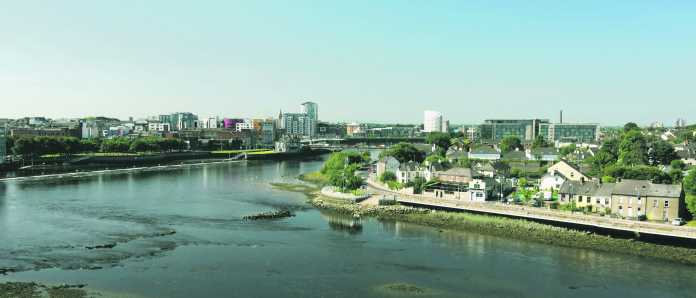

The 2016 figures from the Central Statistics Office (CSO) show the population of Limerick City is 58,319, up 2.1 per cent from the 2011 figure of 57,106. Over the same five year period, Galway City’s population grew by 5.3 per cent from 75,529 to 79,504.
The widening gap between the third and fourth cities, has prompted Limerick Fianna Fáil TD Willie O’Dea to declare that “people in the suburbs should be given the right to decide through a local referendum if they want to be counted as part of the city.”
Asked whether he was personally in favour of such a referendum, Deputy O’Dea, who is the Fianna Fáil spokesman on Social Protection, replied, “I’d be in favour, yeah I would. I think the people should be given the option. Let the popular will prevail.”
However, he refuted suggestions that the latest CSO figures cemented Galway’s status as Ireland’s third most populous city.
“It doesn’t reflect the actual reality. There’s a certain artificiality here; if you look at the totality of the built-up area in Limerick the population far outstrips Galway so from that point of view its artificial.”
“The national media are going on as if the urban area of Limerick is smaller than that of Galway. It isn’t. Anybody who knows about Limerick and Galway would know that,” Deputy O’Dea said.
Limerick City and County Council’s head of communications Laura Ryan told the Limerick Post that there are 102,161 people living in the Limerick City Metropolitan District.
“Following the merger of Limerick City and County Councils in June 2014, a new Metropolitan District of Limerick was formed within the bigger united council which extended the city area.”
“The Metropolitan District includes the city urban area and extends outwards towards Patrickswell in the west and Castleconnell in the east. So Dooradoyle and Raheen are in the greater metropolitan city area”, she explained
With an overall population of 195,175 Limerick is the fifth most populous county in the country behind Dublin, Cork, Galway and Kildare. The population of the city and county combined has risen by 1.8 per cent since 2011 .
Of the 58,319 people categorised by the CSO as living in Limerick City, 29,680 are female and 28,639 are male. In Limerick county, the population has risen to 136,856, with the 68,738 males outnumbering the 68,118 females.
Limerick has seen a natural increase (births less deaths) of 5,528 in population since the previous census.
In terms of overall growth Limerick, along with much of the west, lags behind the eastern counties. With an increase of 1.8 per cent, Limerick’s rise in population is comparable with that of Clare (1.2 per cent), Kerry (1.4 per cent) and Galway (2.2 per cent) but much less than that of Meath (5.9 per cent), Kildare (5.6 per cent) and South Dublin (5.1 per cent).
Limerick County TD, Niall Collins, believes that the CSO figures confirm the emergence of a two-tier recovery and the unbalanced regional spread of economic growth throughout the country.
“This is a very disproportionate concentration of our economy in one region and is not sustainable for either Dublin or the regions in terms of service provision, housing and infrastructure. For Ireland’s recovery to be sustainable and fair, there needs to be balanced social and economic development”, he explained.
Of further concern are the numbers of people leaving Limerick and emigrating either abroad or to elsewhere in the country. With an overall net outward migration of 28,558 Ireland has seen more people leaving than country than entering it for the first time since 1991.
And these theme is evident in Limerick’s figures with a net outward migration of 3,375. This is the third highest figure in the country, with only Donegal (6,731) and South Dublin (4,217) seeing more people leave its environs since 2011.
As a by-product of this emigration, Limerick County now has the the fewest number of persons per TD in the entire country.
With just 27,916 people for every one TD the constituency is below the national limit which is set at 30,000. Overall, the national average is 30,114 people per TD, with some 25 constituencies exceeding the 30,000 limit. The highest number of people per TD was 32,299 in Dublin North-West.
The Boundary Commission is now likely to re-examine the constituencies and some redrawing is inevitable.
However, Minister of State and Limerick Fine Gael TD Patrick O’ Donovan believes it is important to make sure county boundaries are respected by the Commission.
“That didn’t happen in advance of the 2011 election when a huge chunk of West Limerick was put into north Kerry but since then, the two have amalgamated into a single five seater.”
“We’ve also seen changes in the Limerick constituency boundary. “There are seven seats between the two Limerick constituencies. I imagine if there are to be boundary changes it will happen within Limerick itself,” he concluded.
Since the last census, Limerick’s housing stock has risen by just 192, with a total of 82,741 houses in the city and county. The amount of vacant houses has fallen from 10,114 to 8,856, a figure which represents 10.7 per cent of all available houses in Limerick.
On this, Deputy Collins said, “We have over 5,000 persons and families on the housing waiting list, yet now we learn that 8,856 vacant dwellings exist across the city and county. The Government needs to focus on this as part of its housing strategy to bring these properties into use for families on the housing list.”










